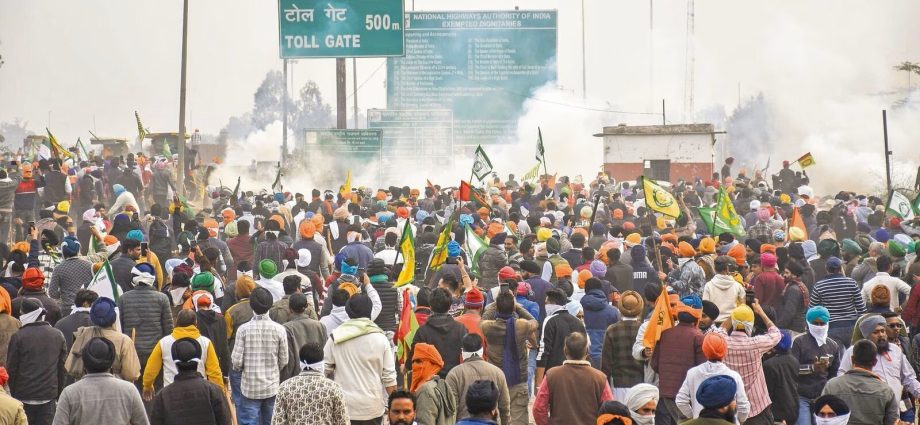By M L Satyan
Coimbatore, Feb 19, 2024: Farmer Protest-1 witnessed more than 700 deaths. Now the Farmer Protest-2 has already witnessed one death and hundreds of injured farmers.
The scenes reported by some YouTube channels are heart-rending. The inhuman ways the food-producers/providers of this country are treated bother me and make me restless and helpless. I write this mainly to sensitize the readers on the pathetic situation of the Indian farmers.
Punjab, Haryana and Uttar Pradesh farmers are on the street again with more than 200 farmer unions heading to Delhi after the last round of talks between the farmer leaders and the Union ministers remained inconclusive. Farmer leaders said there was no clarity of legal guarantee to the minimum support price.
The farmers’ march has turned the city’s main points of entry into choke points, as the federal and local police go into overdrive: barricading highways by pouring concrete and stacking shipping containers to halt the advancing tractors.
The authorities have blocked the social media accounts of some protest leaders and even used drones that were once billed as an agricultural innovation to drop tear-gas grenades on the demonstrators.
Why farmers are protesting now? In 2020, the farmers protested against the three laws which after one year of their protest on Delhi borders were repealed in 2021. “Delhi Chalo” was announced recently demanding a legal guarantee to MSP for all crops, the implementation of Swaminathan Commission’s formula, full debt waiver for farmers, pension for farmers and labourers, withdrawal of cases against farmers during the 2020-2021 protest.
Who is leading the protest? Farmer protest-2 is being spearheaded by different unions as the landscape of the farmers’ unions has changed in the last few years. The Samyukt Kisan Morcha (Non-Political) and the Kisan Mazdoor Morcha have announced Delhi Chalo-02.
The two prominent leaders of the farmers’ 2020 protest were Rakesh Tikait and Gurnam Singh Charuni. But they are nowhere to be seen as the farmers take to the street four years later. Jagjit Singh Dallewal, leader of SKM (non-political) and Sarwan Singh Pandher, general secretary of Kisan Mazdoor Morcha (KMM), are at the forefront now.
What happened in the past? In 1988 Delhi witnessed a memorable farmers’ protest, when Mahendra Singh Tikait, a Jat farmer leader from Uttar Pradesh, laid siege to the capital with a charter of demands. With him, nearly 500,000 farmers with their tractors, cattle and cooking utensils took over the Boat Club lawns – the original protest venue in Delhi, on Rajpath – till the Rajiv Gandhi government finally relented to their demands, which included an increase in the price of sugarcane and some waivers.
It was after Tikait’s sit-in that the protest venue was shifted to Jantar Mantar so agitators could be kept at a safe distance from government buildings.
The farmers from Tamil Nadu held their protest in Delhi’s Jantar Mantar from March to May 2017. It was a non-stop marathon. They were barely more than 100 of them. But, the protest, to a great extent, engaged the attention of the national media.
The farmers were seen doing different kinds of dharna like sitting semi-naked (loincloths for men and petticoats for the women), keeping dead snakes, rats and dry grass in their mouths (to say this is all they get to eat now), acting as if they have become mentally challenged due to increased depression, carrying skulls (a reminder of the farmers’ suicides), holding a mock funeral, tying a noose around each other’s necks, breaking the “mangal sutra” (to show that there is an increase in the number of widows due to farmers’ suicides) and so on. Sadly, none of the above drew the federal government’s attention.
“We have nothing except our lives. What is the point of living like this? 144 farmers committed suicide within three months – from October to December – in 2016. About 400 have ended their lives in one year due to distress caused by non-payment of loans and consecutive crop failure. We are unable to repay our loans. Banks have seized our properties. Our land would be sold if government does not interfere. Many of us mortgaged our wives’ jewelleries to repay the loans but the crisis is still there. No one came to our aid. That is what forced us to come all the way to Delhi,” said Ayyakannu the leader of the protesting farmers.
During Farmer Protest-1 the farmers were able to come to the national capital but this time the administration has taken strict pre-emptive measures. Barbed wire, cement barricade, nails on roads are laid to block the farmers. Tear-gas is used frequently. Section 144 has been imposed in Delhi. Haryana government sealed its borders with Punjab. The government started the negotiation process even before the farmers’ Delhi Chalo march this time. Several rounds of meetings with the Ministers have been futile.
We must understand that these farmers are the citizens of this country. One of the dramatic acts that the Tamil Nadu farmers did in 2017 was: a person dressed up like Modi beats the farmers with a whip. This scene touched me the most. One has to appreciate the creativity and the courage of the farmers in depicting such a scene. This is indeed a shame on the person who holds an honourable and a responsible position of Prime Minister. The PM always wants everyone to listen to his “mann ki baat’’. It is high time for him to listen to the farmers’ mann ki baat.
As responsible citizens we need to express our solidarity with the protesting farmers. We should also condemn the inhuman ways used by the local government and the police to block the farmers from entering Delhi. It is high time the Human Rights Commission and the Judiciary spring into action to protect the rights of the protesting farmers.











